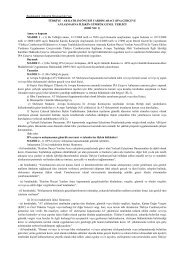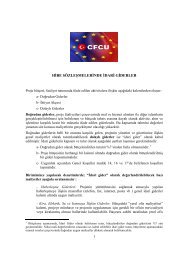Project Cycle Management Training Handbook - CFCU
Project Cycle Management Training Handbook - CFCU
Project Cycle Management Training Handbook - CFCU
Create successful ePaper yourself
Turn your PDF publications into a flip-book with our unique Google optimized e-Paper software.
<strong>Project</strong> <strong>Cycle</strong> <strong>Management</strong> <strong>Training</strong> <strong>Handbook</strong><br />
Who needs the<br />
information?<br />
What for?<br />
6.2.1 Analyse <strong>Project</strong> Objectives<br />
Analysis of objectives during project design has been dealt with in<br />
section 3.1. However, some time may have passed since the project<br />
was designed, and the project environment or the actors involved may<br />
have changed. It is sensible therefore to start implementation with a<br />
project start-up workshop. The purpose of this workshop would be to<br />
bring together the stakeholders to review project documents and key<br />
assumptions. <strong>Project</strong> objectives should be revised to ensure that they<br />
are clearly stated and remain realistic, specific and measurable. These<br />
will now form the basis for the Monitoring & Evaluation system.<br />
6.2.2 Review Implementation Procedures<br />
The logframe provides the framework for identification of<br />
information needs as a whole. It is important though to relate<br />
information needs to the different levels of the management structure.<br />
In reality, the level of detail of information required and the frequency<br />
of reporting will vary according to the level of management. For<br />
example, project administrators will need information about day-today<br />
activities, while the contractor will require more summarised<br />
information about achievement of outputs or deviations from the<br />
workplan which he/she may need to forward to the programme<br />
implementation agency. Figure 31 illustrates this principle. A review<br />
of implementation procedures involves a review of what activities will<br />
be undertaken and by whom. This should be done with reference to<br />
the activity schedule.<br />
By reviewing implementation procedures (who does what) in<br />
consultation with partner institution staff, the various roles, functions<br />
and responsibilities are clarified, and a clear link can be made<br />
between information needs and levels of management. This process<br />
can be assisted by drawing up a table which lists the information user,<br />
what is required, the source of the information, and who is responsible<br />
for preparing the report.<br />
Figure 31: Information Needs and Levels of <strong>Management</strong><br />
Head of Unit<br />
Technical Unit<br />
Delegation<br />
PMU<br />
Component<br />
Volume of information<br />
Summarised<br />
Flow of<br />
information<br />
Detailed<br />
57





